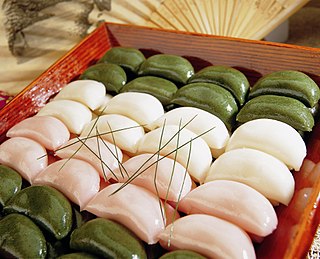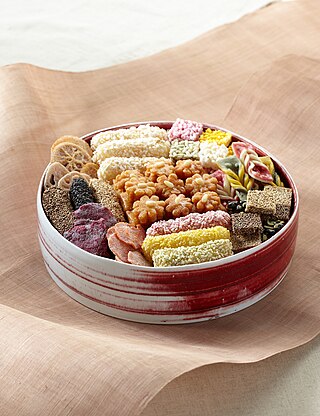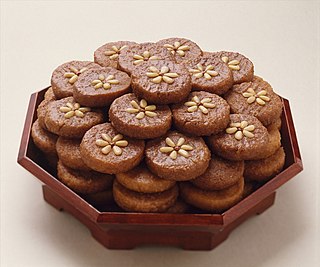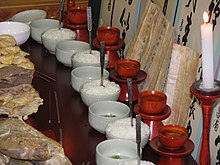
The veneration of the dead, including one's ancestors, is based on love and respect for the deceased. In some cultures, it is related to beliefs that the dead have a continued existence, and may possess the ability to influence the fortune of the living. Some groups venerate their direct, familial ancestors. Certain religious groups, in particular the Eastern Orthodox Churches, Anglican Church, and Catholic Church venerate saints as intercessors with God; the latter also believes in prayer for departed souls in Purgatory. Other religious groups, however, consider veneration of the dead to be idolatry and a sin.

Dangun or Tangun, also known as Dangun Wanggeom, was the legendary founder and first king of Gojoseon, the first Korean kingdom. He founded the first kingdom around the northern part of the Korean Peninsula. He is said to be the "grandson of heaven", "son of a bear", and to have founded the first kingdom in 2333 BC. The earliest recorded version of the Dangun legend appears in the 13th-century Samguk yusa, which cites Korea's lost historical record, Gogi and China's Book of Wei.

Chuseok, also known as Hangawi, is a major mid-autumn harvest festival and a three-day holiday in South Korea celebrated on the 15th day of the 8th month of the lunisolar calendar on the full moon. In North Korea, they only celebrate for the day of chuseok. Like many other harvest festivals around the world, it is held around the autumn equinox, i.e. at the very end of summer or in early autumn. It is the biggest traditional holiday in South Korea.

Songpyeon (Korean: 송편) is a traditional Korean food made of rice powder. Its shape resembles a half moon and it is a representative rice cake of Korean holidays and traditional culture. It is a type of tteok, small rice cakes, and variety of fillings are used—some include red bean paste, toasted sesame seeds, and chestnuts. Songpyeon is traditionally eaten during the Korean autumn harvest festival, Chuseok, where it is often prepared by families at home. It is a popular symbol of traditional Korean culture. The earliest records of songpyeon date from the Goryeo period.

Memil-muk (메밀묵) or buckwheat jelly is a light gray-brown muk (jelly) made from buckwheat starch. It is commonly served as banchan as well as anju.

Jongmyo (Korean: 종묘) is a Confucian royal ancestral shrine in the Jongno District of Seoul, South Korea. It was originally built during the Joseon period (1392–1897) for memorial services for deceased kings and queens. According to UNESCO, the shrine is the oldest royal Confucian shrine preserved and the ritual ceremonies continue a tradition established in the 14th century. Such shrines existed during the Three Kingdoms of Korea period (57–668), but these have not survived. The Jongmyo Shrine was added to the UNESCO World Heritage list in 1995.

Hwangudan (Korean: 환구단) was a shrine complex that still partially stands in Jung District, Seoul, South Korea. The complex consisted of two main buildings: a coronation site and Hwanggungu. The coronation site was built in late 1897 and destroyed in 1913. Hwanggungu was built in 1899 and still stands today.

Seollal is a Korean traditional festival and national holiday commemorating the first day of the lunisolar calendar. It is one of the most important traditional holidays for ethnic Koreans, being celebrated in both North Korea and South Korea as well as Korean diaspora all around the world.

Korean tea is a beverage consisting of boiled water infused with leaves, roots, flowers, fruits, grains, edible mushrooms, or seaweed. It may or may not contain tea leaves.

Heotjesatbap, a traditional Korean dish, is a variety of bibimbap, served with soy sauce (ganjang) instead of the gochujang that is more commonly used. Heotjesabap consists of mainly several types of namul over white rice. It is also served with grilled fish and some jeon.

Hangwa is a general term for traditional Korean confections. With tteok, hangwa forms the sweet food category in Korean cuisine. Common ingredients of hangwa include grain flour, fruits and roots, sweet ingredients such as honey and yeot, and spices such as cinnamon and ginger.

Jongmyo jerye (Korean: 종묘제례) or jongmyo daeje (종묘대제) is a traditional rite held for worshipping the deceased Joseon monarchs in Jongmyo Shrine, Seoul, South Korea. It is held every year on the first Sunday of May. The jongmyo rite is usually accompanied with the court music playing (Jerye-ak) and dance called Ilmu or line dance. Jongmyo jerye and jeryeak were designated as Masterpieces of the Oral and Intangible Heritage of Humanity by UNESCO in 2001.

Yakgwa (Korean: 약과), also called gwajul (과줄), is a type of yumil-gwa, which is deep-fried, wheat-based hangwa made with honey, cheongju, sesame oil, and ginger juice. Traditionally, the sweet was offered in a jesa and enjoyed on festive days such as chuseok, marriages, or hwangap (sixtieth-birthday) celebrations. In modern South Korea, it is also served as a dessert and can be bought at traditional markets or supermarkets.

The Yemaek or Yamaek are an ancient tribal group native to the northern Korean Peninsula and Manchuria and are commonly regarded as the ancestors of modern Koreans. The Yemaek have ancestral ties to multiple kingdoms in Northeast Asia including Gojoseon, Buyeo, Goguryeo, and multiple tribes including Okjeo, Dongye, Yangmaek and the Sosumaek.
Traditions of Korean family ceremonies were mainly established during the Joseon dynasty (1392–1910), which adopted Confucianism as a state philosophy. As Korean society became Confucianized, the four family ceremonies of Confucian culture have developed elaborately, and continue to influence Korean life to the present day. Ceremonial food was an important part of such cultural tradition and developed with variations across different regions and cultures.
The Four Ceremonial Occasions. The four rites of passage celebrated in this tradition are the coming of age, marriage, death, or the funeral rites, and rites venerating the ancestors. The word Gwanhonsangje an acronym, made of the first letter of each word.
Josang refers to one's immediate ancestors, offspring, a deceased relative or any unrelated soul; and worshipped as a god in Korean Shamanism. It is viewed as a supernatural being rather than blood relations, includes all immediate and extended family, both male and female, and all other deceased souls that influence the family. These include who died before marriage, or who died a tragic, untimely death.

The Confucian royal ancestral shrine (宗廟制) is a system of Confucian worship for royal ancestors in East Asian region. It is historically originated from Chinese culture, yet later redeveloped among countries in East Asian cultural sphere as cultural diffusion. Nowadays this system became famous around the world for its authentic cultural heritage preserved in Korea, 'Jongmyo', designated as UNESCO World Heritage Site in 1995.

Sacrifice to Heaven is an Asian religious practice originating in the worship of Shangdi in China. In Ancient Chinese society, nobles of all levels constructed altars for Heaven. At first, only nobles could worship Shangdi but later beliefs changed and everyone could worship Shangdi.


















